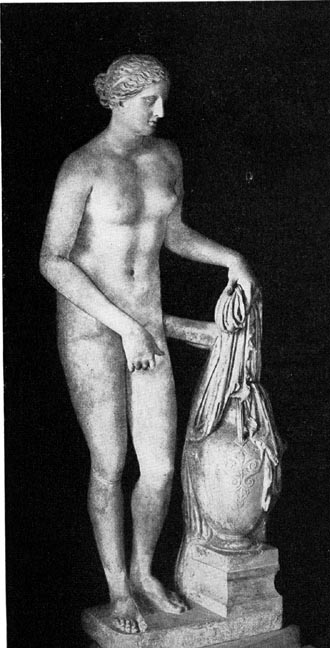


Left: The Aphrodite of Melos. Middle: the Knidian Aphrodite. Right : the Tinted Venus. Click on thumbnails for larger images.
Sculpting the human figure in stone, whether clothed or unclothed, male or female, presents the artist with certain constraints related to the weight and strengh of materials used that those who work with bronze do not encounter, at least to such a degree. The problem, simply put, involves fonding a way to support the weight of the figure's upper body on what Kenneth Clark calls two "tapering, spindly supports". The Aphrodite of Melos, one of the most famous of all surviving stues from ancient Greece, provided one often-imitated solution” by draping the lower hald of the body thus creaing a strong triangular or pyramidal base. Another method, necessary when the artist wants to emphasis the beauty of the figure's legs, appears in the Knidian Venus (or Aphrodite) where the sculptor first places a verical element along side the figure — in this case Aphrodite's clothing, which she is placing on top of an urn. The sculptor has left a thick cylinder of supporting stone (which the spectator has to ignore) between Aphrodite's hip and the drapery. John Gibson's Tinted Venus (1851-56), one of the most famous English statues in the first six decades of the nineteenth century, has a similar solution, placing most of the the figure's weight on her left leg, bending the right, and having her just removed clothing drape over her left arm and touch the ground, thus creating a firm support.



Immolate. >Middle: the Knidian Aphrodite. Right: Charles bell Birch's Wood Nymph. Click on thumbnails for larger images.
Other solutions to this structural problem of a standing nude figure include that found in Clemens sculpture of a female martyr, where the pillar to which she is bound bears much of the weight. An entirely diferent set of poses avoids the problemns of the standing figure” by having the figure sit, as in E. H. Baily's Eve and Charles bell Birch's Wood Nymph, or kneel, as in Marget Giles's Hero.


Left: Bramwell's Hero Mourning over the Body of Leander. Left: Giles's Hero .
Yet another means of strengthening the statue comes when the sculptor hass his figure recline as in and Joseph Durham's
Waiting for His Innings, or adds a second figure, as in Bramwell's Hero Mourning over the Body of Leander.
Bibliography
Clark, Kenneth. The Nude: A Study in Ideal Form. Bollingen Series 35.2. New York: Pantheon Books, 1956.
Last modified 16 February 2007